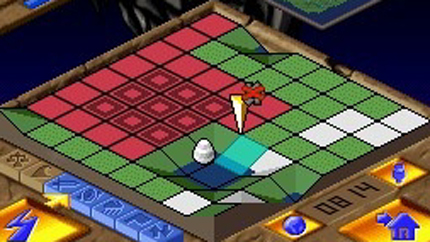Populous deserves its place in the history books. The Bullfrog god sim was revolutionary back in 1989, a genre-changing masterpiece that altered the landscape for strategy gaming in more ways than one. But it's probably better left as a memory. This remake for the Nintendo DS is an exercise in nostalgia that will be enjoyed only by old-timers who experienced the original in all its late-'80s glory. While you have to give the developers credit for sticking tight to the 20-year-old design in an era of glitz and glam, you also have to wonder how anyone could have thought that such an ancient game could fly in 2008.

Populous for the DS is still a straightforward god game where you take on the role of one of five good elemental deities overseeing the development of towns at the same time as a rival demon is building up a similar community of followers on the other side of the map. You play a divine landscaper of sorts. Most of your world-building efforts are confined to leveling terrain so that worshippers can promote your greatness through the construction of ever more elaborate homes. More houses leads to more happy, healthy people, who are needed at the end of each level to smack down the enemy demon's goons in an Armageddon free-for-all determining who gets to be all Zeus-like and who doesn't. Win this fight in the Challenge mode solo campaign (there is also Wi-Fi multiplayer support for up to four players) and you'll move on to do it all over again against another big bad demon in another world.
All you'll really need to do is find a balance between three tasks: alter enough terrain to provide for the best possible building opportunities; keep an eye on the health of your worshippers via their spirit scores; and leave your worshippers enough time off in their homes to get in the groveling needed to boost your divine power, called psyche energy. Because your drones can't worship while building, yet will die if they don't have proper shelter, you'll have to fiddle around so you don't wind up building-rich and psyche-poor. Worshippers, buildings, and psyche are all vital components in winning a level. You'll need people to build and fight the final battle, homes to keep people alive and provide places for worship, and psyche to fire up miracles that devastate demon settlements. Nothing sets back town-building like an inopportune meteor strike or an earthquake.
But where the strategy involved here seemed deep and imaginative in 1989, today it comes off as shallow and predictable. There just isn't enough variety here to keep you interested beyond a couple of levels, although each has at least been given distinct buildings and features that help and hinder your godly tasks. You fight for divine provenance over everything from generic grass plains, snowfields, and Persian-inspired deserts to special realms such as a fairy tale world based on Candyland, a horror land with gothic castles, and 8-Bit Plain, where worshippers build consoles and handheld gaming systems from Nintendo's storied past. Some levels have hardier worshippers, some weaker. Others have terrain restrictions making it harder to build houses. Building on the lava-strewn magma level isn't easy, for example.
Still, gameplay basics never change much, even with these variables. So you'll quickly fall into a pattern of pulling terrain up and down, taking consolidation breaks to allow worship and psyche to build up, and launching disasters whenever your enemy seems to be making too much progress. After the initial nostalgic rush wears off, you won't be able to play for longer than a few minutes at a time without getting bored. So even though this might seem to be an epic strategy game, you have to play it in short, one-level-at-a-time spurts as you would a puzzle game or one of the minigame collections that the DS does so well. Not that there's necessarily anything wrong with that, although having to chew the game in bite-size chunks is certainly much different than the full-blown obsession that had people playing the original for untold hours on end back in 1989.

At least the touch-screen-only interface is outstanding. The game makes such tremendous use of the stylus to manipulate terrain that you might stick around for an extra couple of levels just to play with this feature. All landscaping is handled on the bottom screen, with the end results being displayed on the main map screen above. It works pretty much seamlessly and is perfectly intuitive, with the only niggle being how it can be more difficult to grab onto terrain at the edges of the screen. Graphics are also pretty good, if a bit on the archaic side, presumably to give the game more retro cred. Each level has a unique look that provides added personality through its buildings, which run from candy mansions to old Nintendo consoles like the SNES, but the terrain itself is bland and people are just tiny blobs. The Armageddon battle is more goofy than dramatic, with these little folks waddling toward one another and then slap-fighting until only one survivor remains. Audio is nearly nonexistent, with sound effects that you barely take notice of during levels and a variable soundtrack that comes off as more of a blah ode to the 16-bit era than anything distinctive.
If you're young enough to think the Commodore Amiga is some kind of hat worn in the Mexican navy, Populous for the Nintendo DS is probably not for you. All this remake shows us is that 1989 was a long time ago, and that Populous needs a proper reimagining along the lines of Sid Meier's Pirates! to be relevant to a modern world.